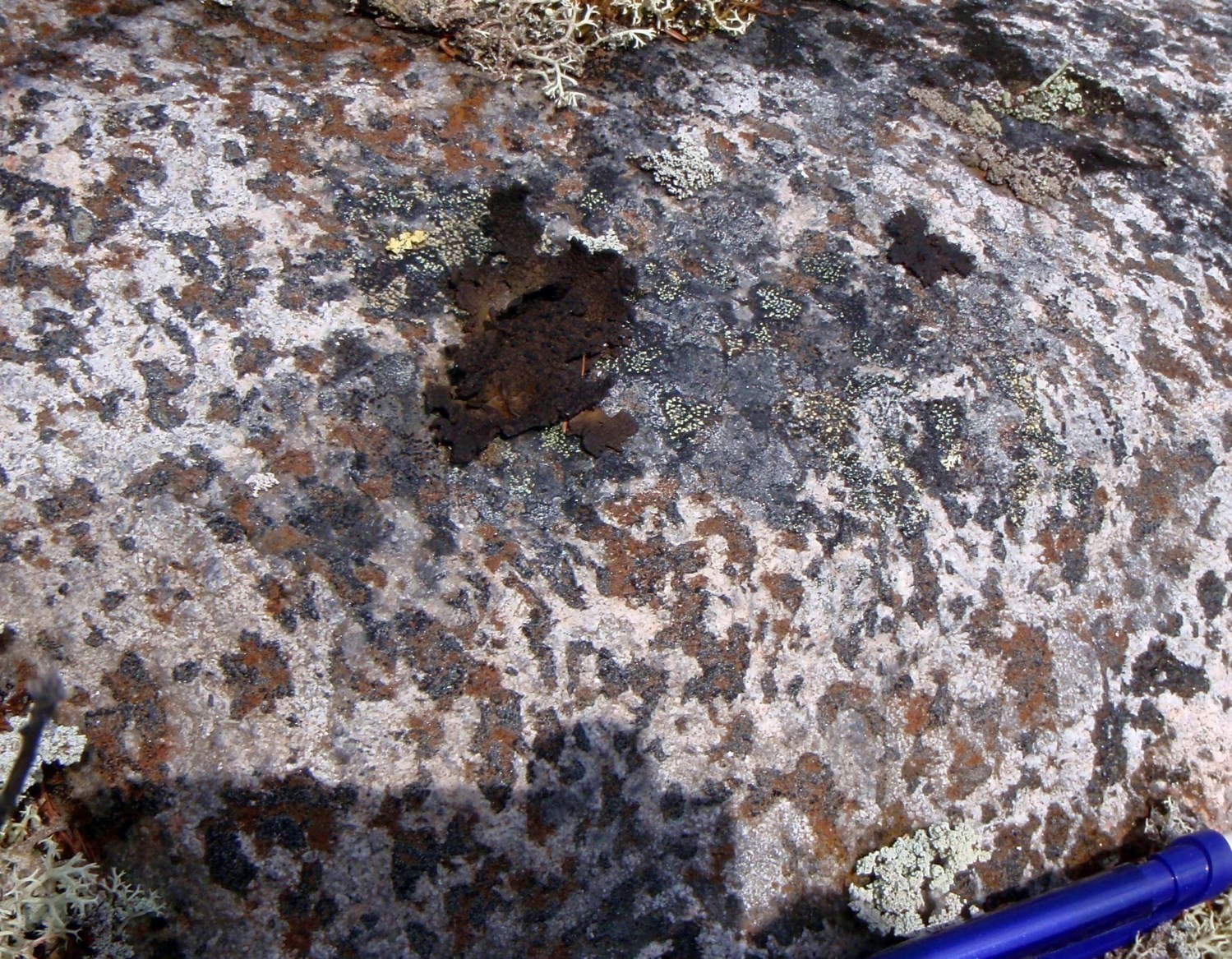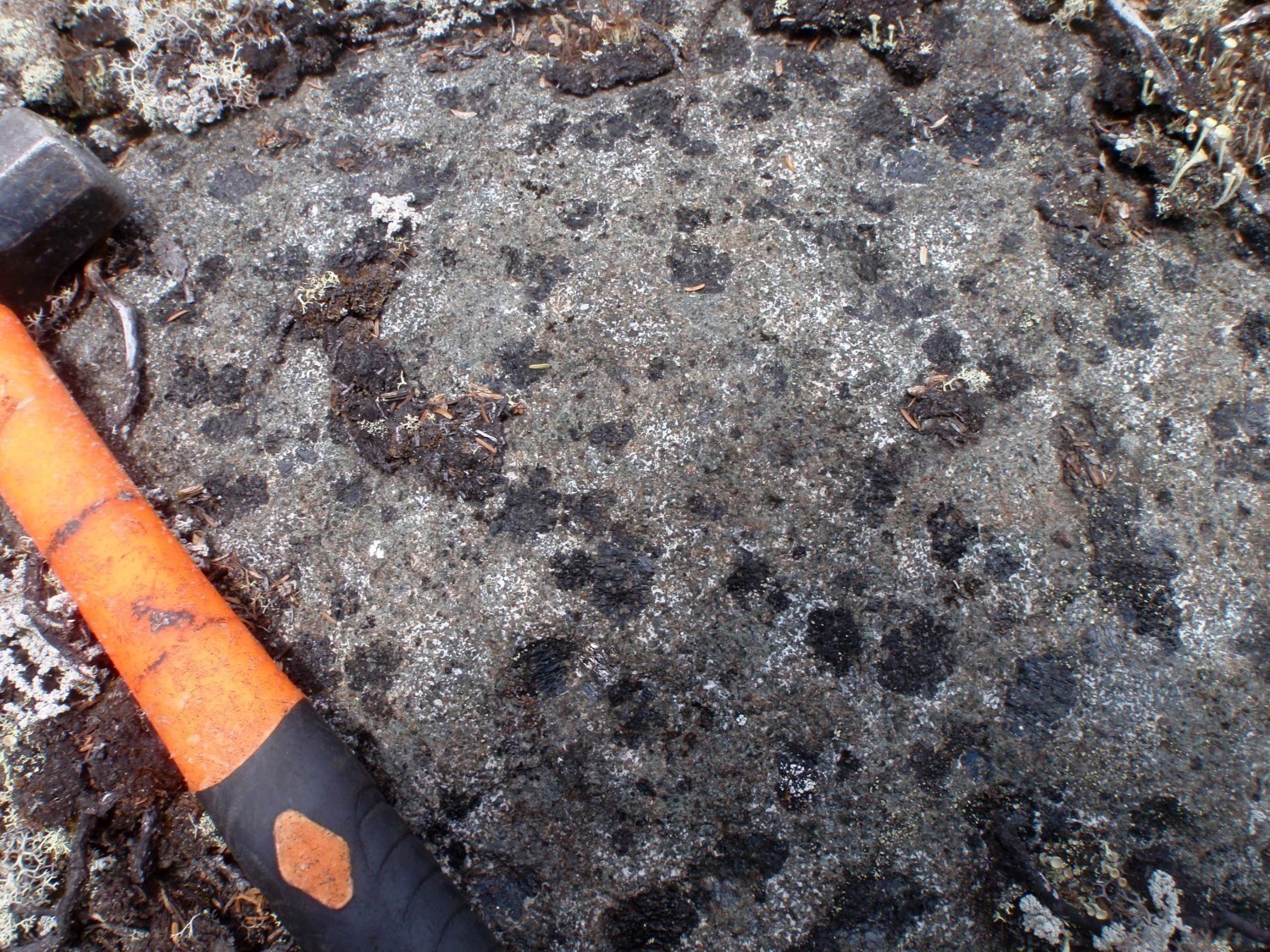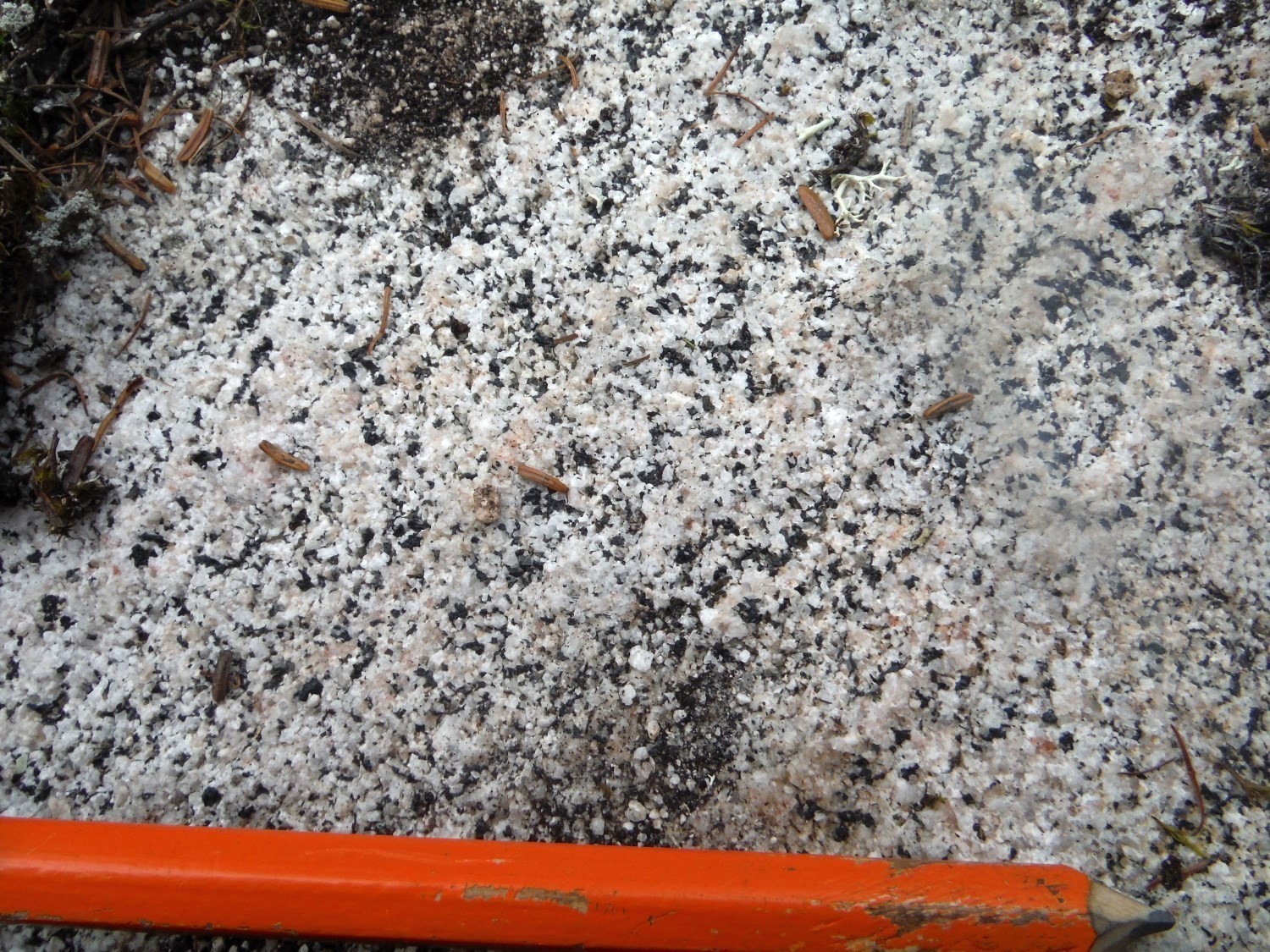
DISCLAIMER: This English version is translated from the original French. In case of any discrepancy, the French version shall prevail.
| Author: | Charette et al., 2016 |
| Age: | Paleoproterozoic |
| Stratotype: | None |
| Type area: | Jeannin Lake area (NTS sheet 24B) |
| Geological province: | Churchill Province |
| Geological subdivision: | Baleine Lithotectonic Domain |
| Lithology: | Leucogabbronorite, quartz diorite and opdalite |
| Category: | Lithodemic |
| Rank: | Suite |
| Status: | Formal |
| Use: | Active |
None
Background
The Lhande Suite was introduced in the Jeannin Lake area by Charette et al. (2016).
Description
The Lhande Suite consists of three informal units: 1) speckled quartz diorite; 2) leucogabbronorite, quartz monzogabbro, pyroxenite and gabbronorite; and 3) opdalite, charnockite and quartz monzodiorite.
Lhande Suite 1 (pPlnd1): Speckled Quartz Diorite
Unit pPlnd1 consists mainly of quartz diorite, but also includes diorite, monzodiorite and tonalite. The rock is characterized by its black-and-white speckled appearance and homogeneous texture. It is foliated, medium grained and not magnetic. Despite partial recrystallization, igneous textures are well preserved. Ferromagnesian minerals (15-30%) form millimetric to centimetric clusters. They consist of similar contents of hornblende and brown to dark brown biotite. Microcline forms small interstitial crystals, while quartz displays undulatory extinction and subgrain development. Plagioclase twins are locally deformed. Accessory minerals are abundant and tend to be attached to ferromagnesian clusters. Apatite and sphene can be of notable amounts (1%) and generally form clusters of small crystals. Ferromagnesian minerals and sphene define foliation. Other accessory minerals commonly observed are opaque minerals, epidote, allanite and zircon. Carbonates, muscovite, chlorite, hematite and sulphides are sparser.
Lhande Suite 2 (pPlnd2): Leucogabbronorite, Quartz Monzogabbro, Pyroxenite and Gabbronorite
Unit pPlnd2 consists of leucocratic mafic intrusions (pPlnd2a) and melanocratic ultramafic to mafic intrusions (pPlnd2b).
Lhande Suite 2a (pPlnd2a): Magnetic Leucogabbronorite and Quartz Monzogabbro
Subunit pPln2a consists of homogeneous, massive to slightly foliated and very highly magnetic leucogabbronorite and quartz monzogabbro. The speckled appearance is associated with the presence of fine-grained, millimetric to centimetric clusters of black ferromagnesian minerals, and white or violet silicate minerals. These are granoblastic and consist mainly of microcline (<15%) ± quartz (<5%). Some coarser plagioclase grains recrystallized at the edge are also preserved. Microcline forms an interstitial phase with plagioclase crystals and locally forms larger microperthitic crystals with myrmekitic borders. Ferromagnesian clusters (20-35%) are composed of hornblende, clinopyroxene, biotite and orthopyroxene. Hornblende forms poikiloblasts (0.5-1 cm) rich in quartz inclusions. These poikiloblasts commonly display a fine-grained recrystallized border and are surrounded by a darker amphibole. Clinopyroxene is generally observed in small crystals preserved in the core of hornblende, but also in clusters of joint crystals or large subhedral crystals, both of which are highly uralitized. Biotite occurs as clusters of intergrown flakes or large felts. Orthopyroxene is altered (iddingsite) and observed in the centre of biotite clusters. Hornblende and biotite commonly form intergrowth with quartz. Accessory minerals are apatite, opaque minerals, muscovite, carbonates and zircon.
Lhande Suite 2b (pPlnd2b): Pyroxenite and Melanocratic Gabbronorite
Pyroxenite and gabbronorite of subunit pPlnd2b are non-magnetic, massive and medium grained. Dark green or light green, they contain 80-99% ferromagnesian minerals. Plagioclase is interstitial and granoblastic. Pyroxenite is composed of clinopyroxene and orthopyroxene more or less altered to uralite or iddingsite, respectively. Locally, pyroxenes are completely replaced by a mixture of tremolite-actinolite and chlorite-felted clusters. Pyroxenite may also contain up to 15% fractured and variably serpentinized olivine. Secondary minerals observed in thin sections are carbonates, talc, spinel, opaque minerals, phlogopite and anthophyllite. Gabbronorite is composed of large pyroxene crystals and ~15-25% brown hornblende poikiloblasts. Clinopyroxene is uralitized and orthopyroxene is highly altered. Gabbronorite also contains smaller amounts of phlogopite, carbonates, quartz and opaque minerals.
Lhande Suite 3 (pPlnd3): Opdalite, Charnockite and Quartz Monzodiorite
Unit pPlnd3 consists of felsic to intermediate intrusive rocks associated with mafic intrusions of unit pPlnd2. It includes opdalite, charnockite and quartz mangerite. The rock is generally deformed and altered, characterized by the presence of quartz bands, thin deformation corridors marked by significant grain size reduction, well-developed foliation or stretch lineation, as well as common hematitization. Unit pPlnd3 is fine to medium grained, variably recrystallized, and typically contains small fractured and serpentinized orthopyroxene crystals (<3%). In this case, the rock takes on a characteristic light brown sugar colour. Locally, charnockite has a gneissic appearance and displays alternating centimetric bands of various compositions (charnockite, pink granite and enderbite). The K-feldspar content varies with composition (10-50%), whereas ferromagnesian minerals, mainly biotite and epidote, account for 5-15% of the mode. Apatite, sphene, allanite, opaque minerals, muscovite and zircon are observed in thin sections as accessory minerals.
Thickness and distribution
The Lhande Suite (335 km2) forms hectometre to kilometre-wide by 1-20 km-long intrusions in the south-central part of the Baleine Lithotectonic Domain (Lafrance et al., 2020), specifically in the Jeannin Lake area (sheet 24B). Unit pPlnd1 (213 km2) covers the largest area. Unit pPlnd2 (87 km2) is associated with strong magnetic anomalies, typically lenticular, 2-12 km long by 1-4 km wide. Unit pPlnd3 (35 km2) is generally observed along the edge of unit pPlnd2.
Dating
A crystallization age around 1834 Ma was obtained in a quartz diorite of the Lhande Suite (pPlnd1). This age is contemporaneous with the emplacement of other intrusive units within the Baleine Domain, namely the Champdoré Suite (1859-1837 Ma), Kaslac Complex (1835-1828 Ma), De Pas Supersuite (1862-1805 Ma), Kuujjuaq Pluton (1869-1833 Ma), as well as crystallization of diatexites of the Winnie Suite (1839-1838 Ma).
| Unit | Sample Number | Isotopic System | Mineral | Crystallization Age (Ma) | (+) | (-) | Metamorphic Age (Ma) | (+) | (-) | Reference(s) |
| pPlnd1 | 2015-IL-3057 | U-Pb | Zircon | 1834 | 5 | 5 | 1805 | 23 | 23 | Rayner et al., 2017 |
Stratigraphic Relationship(s)
The Lhande Suite is cut by granitic or tonalitic intrusions of the Aveneau and Dancelou suites. Mafic and ultramafic rocks of unit pPlnd2 were also observed as centimetric to metric enclaves within rocks of the Aveneau Suite.
Paleontology
Does not apply.
References
Publications available through SIGÉOM Examine
CHARETTE, B., LAFRANCE, I., MATHIEU, G., 2016. Géologie de la région du lac Jeannin, Québec, Canada. MERN; BG 2015-01, 1 plan.
LAFRANCE, I., VANIER, M.-A., CHARETTE, B., 2020. Domaine lithotectonique de Baleine, sud-est de la Province de Churchill, Québec, Canada: synthèse de la géologie. MERN; BG 2020-07, 4 plans.
Other publications
RAYNER, N.M., LAFRANCE, I., CORRIGAN, D., CHARETTE, B., 2017. New U-Pb zircon ages of plutonic rocks from the Jeannin Lake area, Quebec: an evaluation of the Kuujjuaq Domain and Rachel-Laporte Zone. Geological Survey of Canada, Current Research (Online) 2017-4, 14 pages. https://doi.org/10.4095/306180
Suggested Citation
Ministère de l’Énergie et des Ressources naturelles (MERN). Lhande Suite. Quebec Stratigraphic Lexicon. https://gq.mines.gouv.qc.ca/lexique-stratigraphique/province-de-churchill/suite-de-lhande_en [accessed on Day Month Year].
Contributors
|
First publication |
Isabelle Lafrance, P.Geo., M.Sc. isabelle.lafrance@mern.gouv.qc.ca (redaction) Mehdi A. Guemache, P.Geo., Ph.D. (coordination); Thomas Clark, P.Geo., Ph.D.; James Moorhead, P.Geo., Ph.D. (critical review); Claude Dion, Eng., M.Sc. (editing); Céline Dupuis, P.Geo., Ph.D. (English version). |
|
Revision(s) |
Isabelle Lafrance, géo., M. Sc. isabelle.lafrance@mern.gouv.qc.ca (redaction; 06/08/2019) Mehdi A. Guemache, P.Geo., Ph.D. (coordination); Simon Auclair, P.Geo., M.Sc. (editing); Céline Dupuis, P.Geo., Ph.D. (English version); Ricardo Escobar Moran (HTML editing). |
7 février 2020





